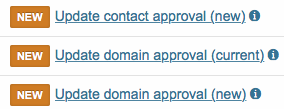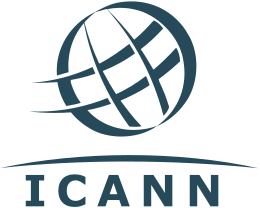Early 2009, .TEL started out with about 120,000 registrations. In the next year, it grew to a 250,000 and registrations reached their peak in 2011 with about 340,000 registrations. After this, the numbers started to decline rapidly. Currently there are slightly less .TEL names registered then short after the start of the general availability in 2009.
A crippled TLD?
The .TEL was promoted as a platform for publishing contact details online through a dedicated telhosting platform. You might consider it like an online Rolodex. The use of this extension was restricted to this platform. This was of course a limitation …
Eight new email templates and six web page templates are available in the production environment. Of course, we made sure they are easy to spot. All essential information is already in the templates.
page templates are available in the production environment. Of course, we made sure they are easy to spot. All essential information is already in the templates.
I recommend adding extra information to your templates. For instance: you can add information in your customers’ native language or encourage them to get in touch with you if they have any questions.
The web templates are used for the confirmation forms at mydomainprovider.com. That is the branded environment in which your customers accept changes, transfers and validations. The email templates are sent in HTML format …
At Realtime Register, we aim to empower our partners’ businesses by providing an extensive collection of TLDs to choose from. That’s why we’re excited to introduce more than 30 new ccTLDs! Give your customers the opportunity to get their share of one of the fastest emerging markets worldwide by adding the Brazilian extension .com.br to your TLD portfolio! And did you know that .io is still one of the hottest domain name extensions for startups and tech companies? New business opportunities await! You’ll find an overview of your prices of in your Domain Manager.
| .ac | Ascension Island |
| .ae | United … |
Familiarize yourself with the upcoming transfer policy changes by reading the Realtime Register IRTP-C newsletter and the checklist below.
How this policy will impact your business
Once the IRTP-C is in effect, the impact will be noticeable for resellers and their end users. The most important changes are:
- It will no longer be possible to change the registrant of a domain name with a simple domain modification request;
- Any Material Change of the registrant’s details of any gTLD domain will invoke a (branded) request for approval, unless the reseller acts a Designated Agent;
- After the Material Change has been …
Familiarize yourself with the upcoming transfer policy changes by reading the Realtime Register IRTP-C newsletter and the checklist below.
How this policy will impact your business
Once the IRTP-C is in effect, the impact will be noticeable for resellers and their end users. The most important changes are:
- It will no longer be possible to change the registrant of a domain name with a simple domain modification request;
- Any Material Change of the registrant’s details of any gTLD domain will invoke a (branded) request for approval, unless the reseller acts a Designated Agent;
- After the Material Change has been …
IRTP-C
On December 1, 2016, the Inter-Registrar Transfer Policy will be updated to IRTP-C. ICANN designed this policy to prevent domain name theft. We are not entirely satisfied how the policy has evolved. Because we made serious efforts to steer things in a better direction, the resulting policy offers some hooks to fit into daily operations.
This email covers the following topics:
Summary of the IRTP-C;
Key Concepts;
Affected Operations;
Required Actions;
IRTP-C maintenance window.
Summary of the IRTP-C
If the registrant data is changed in such a way that the ownership might transfer to another person and or organization, …
It is hard to keep up with all new TLD’s . Check out our GA calendar to know which new TLD enters General availability at what day and time. As we go along more TLDs and Registries will be added.
| .storage | 2016-01-10 | 16:00 UTC | Self Storage Company LLC | Look what we’ve got in store for you. | Registration is unrestricted. |
| .moi | 2016-11-29 | 00:00 UTC | GMO Registry, Inc. | Who? Me? The French TLD that’s for yourself. | Registration is unrestricted. |
| .shopping | 2016-09-28 | 16:00 UTC | Over Keep LLC | Shoppers will love this TLD | Registration is unrestricted. |
| .shop | 2016-09-26 | 15:00 UTC | GMO Registry, Inc. | The … |
This newsletter was sent Tuesday, May 24, 2016

Securing profitable growth for our partners is always on top of the agenda at Realtime Register. Keeping track of the latest developments in the domain business is an important part of this objective. Curious which topics are keeping us busy this month? Check out the latest news below.
Registrar Gateway
One platform for your own accreditations
There is nothing so constant as change itself – a true fact in the domain name registration business. Each TLD has its own set of requirements and compliance rules change on a regular basis. This forces …
Not your usual suspects
This summit has a different setup compared to regular ICANN meetings. The main difference is that only the contracted parties will be engaging, i.e. Registrars and Registries and of course ICANN, allowing us to deal with topics that normally aren’t on the agenda.

English: This is a logo for ICANN. Magyar: ICANN logo (Photo credit: Wikipedia)
What’s on the menu?
A whole array of topics will be discussed during these three days. Let me give you a little background information regarding some of the sessions.
TLD & Universal Awareness, not to be confused with Universal Acceptance. …
This newsletter was sent Wednesday, April 26, 2016

At Realtime Register we constantly challenge ourselves to find new ways for adding even more value to your domain business. Innovation is an integral part of this objective. Curious which new improvements we’re currently working on? Check out the latest news below.
Domain Transfer Service
Transferring large amounts of domains manually can be quite a hassle. And with the updated Inter-Registrar Transfer Policy (IRTP-C) approaching, this process will be bound to even more rules and technical requirements. Instead of devoting all of your time figuring out which rules do and …
 page templates are available in the
page templates are available in the 

